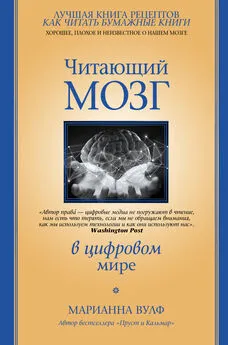Марианна Вулф - Пруст и кальмар. Нейробиология чтения
- Название:Пруст и кальмар. Нейробиология чтения
- Автор:
- Жанр:
- Издательство:ООО «Издательская Группа «Азбука-Аттикус»
- Год:2020
- Город:Москва
- ISBN:978-5-389-18966-9
- Рейтинг:
- Избранное:Добавить в избранное
-
Отзывы:
-
Ваша оценка:
Марианна Вулф - Пруст и кальмар. Нейробиология чтения краткое содержание
В этой книге, мгновенно завоевавшей мировую известность, видный американский нейробиолог Марианна Вулф исследует, как «открытая архитектура», пластичность нашего мозга помогает и мешает людям в их попытках научиться читать и обрабатывать письменный язык. Читателю предстоит увлекательное путешествие по временам и эпохам, знакомство с разнообразными иллюстрациями развития отдельного человека – от младенца, который слушает колыбельную, до настоящего эксперта – читателя произведений Пруста. Разобравшись, как эволюция и развитие чтения изменили само устройство человеческого мозга и суть нашей интеллектуальной жизни, мы поймем, что мы – это действительно то, что мы читаем.
В формате PDF A4 сохранён издательский дизайн.
Пруст и кальмар. Нейробиология чтения - читать онлайн бесплатно ознакомительный отрывок
Интервал:
Закладка:
Еще одна проблема – реакция на специальную терапию детей с затруднениями чтения. В некоторых школах диагноз зависит от отрицательной реакции ребенка на успешную во всех других отношениях терапию. См.: See L. Fuchs and D. Fuchs (1998). Treatment Validity: A Simplifying Concept for Reconceptualizing the Identification // Learning Disabilities Research and Practice, 4. P. 204–219.
Другая тема, на которой делается акцент в этой книге, касается нейробиологических причин дислексии. См.: B. McCandliss and K. Noble (2003). The Development of Reading Impairment // Mental Retardation and Developmental Disabilities, 9. P. 196–203.
6. A. Ellis (1987). On Problems in Developing Culturally Transmitted Cognitive Modules // Mind and Language, 2 (3). P. 242–251.
7. См. обзоры в следующих публикациях: M. Habib (2000). The Neurological Basis of Developmental Dyslexia: An Overview and Working Hypothesis // Brain, 123. P. 2373–2399; S. Heim and A. Keil (2004). Large-Scale Neural Correlates of Developmental Dyslexia // European Child and Adolescent Psychiatry, 13. P. 125–140; McCandliss and Noble. The Development of Reading Impairment. Полезны также книги: V. Berninger and T. Richards (2002). Brain Literacy for Educators and Psychologists. New York: Academic Press; S. A. Shaywitz (2003). Overcoming Dyslexia. New York: Knopf; M. J. Snowling (2002). Reading Development and Dyslexia // Handbook of Cognitive Development. U. C. Goswami (ed.). Oxford: Blackwell. P. 394–411.
8. A. Kussmaul (1877). Die Störungen der Sprache: Versuch einer Pathologie der Sprache. Leipzig: F. C. W. Vogel.
9. J. Déjerine (1892). Contribution à l’étude anatomo-pathologique et clinique des différentes variétés de cécité verbalè // Mém. Soc. Biol., 4. P. 61. Эта работа рассматривалась Норманом Гешвиндом, см.: N. Geschwind . The Anatomy of Acquired Disorders of Reading // Selected Papers. Dordrecht-Holland: Reidel. P. 4–19.
10. N. Geschwind (1965). Disconnexion Syndromes in Animals and Man // Brain, 27. P. 237–294, 585–644.
11. L. Fildes (1921). A Psychological Inquiry into the Nature of the Condition known as Congenital Word-Blindness // Brain, 44. P. 286–307.
12. P. Schilder (1944). Congenital Alexia and Its relation to Optic Perception // Journal of Genetic Psychology, 65. P. 67–88.
13. J. Kavanagh and I. Mattingly (eds.) (1972). Language by Ear and by Eye: The Relationship between Speech and Reading. Cambridge, Mass.: MIT Press. См. также следующие работы: D. Shankweiler and I. Liberman . Misreading: A Search for Cause. P. 293–317; M. Posner, J. Lewis , and C. Conrad . Component Processes in Reading: A Performance Analysis. P. 159–204; P. Gough . One Second of Reading. P. 331–358.
14. V. Hanson, I. Liberman , and D. Shankweiler (1983). Linguistic Coding by Deaf Children in Relation to Beginning Reading Success // Haskins Laboratories Status Report on Speech Research 73.
15. I. Y. Liberman et al. (1977). Phonetic Segmentation and Recoding in the Beginning Reader // Toward a Theory of Reading: The Proceedings of the CUNY Conference. A. S. Reber and D. L. Scarborough (eds.). Hillsdale, N.J.: Erlbaum; K. A. Hirsh-Pasek (1981). Phonics without Sounds: Reading Acquisition in the Congenitally Deaf. Неопубликованная диссертация, Пенсильванский университет; R. B. Katz, D. Shankweiler , and I. Y. Liberman (1981). Memory for Item Order and Phonetic Recording in the Beginning Reader // Journal of Experimental Child Psychology, 32. P. 474–484.
16. F. R. Vellutino (1979). Dyslexia: Theory and Research. Cambridge, Mass.: MIT Press; F. R. Vellutino (1980). Alternative Conceptualizations of Dyslexia: Evidence in Support of a Verbal-Deficit Hypothesis // Thought and Language/Language and Reading. M. Wolf, M. K. McQuillan, and E. Radwin (eds.). Cambridge, Mass.: Harvard Educational Review. P. 567–587; F. Vellutino and D. Scanlon (1987). Phonological Coding, Phonological Awareness, and Reading Ability: Evidence from a Longitudinal and Experimental Study // Merrill-Palmer Quarterly, 33. P. 321–363.
17. Один из примеров можно найти в статье: U. Goswami et al. (2002). Amplitude Envelope Onsets and Developmental Dyslexia: A New Hypothesis // Proceedings of the National Academy of Science, 99. P. 10911–10916.
18. Shaywitz . Overcoming Dyslexia.
19. J. K. Torgesen (1999). Phonologically Based Reading Disabilities: Toward a Coherent Theory of One Kind of Learning Disability // Perspectives on Learning Disabilities. R. J. Sternberg and L. Spear-Swerling (eds.). New Haven, Conn.: Westview. P. 231–262; J. K. Torgesen, C. A. Rashotte , and A. Alexander (2001). Principles of Fluency Instruction in Reading: Relationships with Established Empirical Outcomes // Dyslexia, Fluency, and the Brain. M. Wolf (ed.). Timonium, Md.: York. P. 333–355; J. K. Torgesen et al. (1999). Preventing Reading Failure in Young Children with Phonological Disabilities: Group and Individual Responses to Instruction // Journal of Educational Psychology, 91. P. 579–593; J. K. Torgesen (2004). Lessons Learned from Research on Interventions for Students who Have Difficulty Learning to Read // The Voice of Evidence in Reading Research. P. McCardle and V. Chabra (eds.). Baltimore, Md.: Brookes. P. 355–38.
20. M. W. Lovett, L. Lacerenza, S. L. Borden, J. C. Frijters, K. A. Steinbach , and M. DePalma (2000). Components of Effective Remediation for Developmental Reading Disabilities: Combining Phonologically and Strategy-Based Instruction to Improve Outcomes // Journal of Educational Psychology, 92. P. 263–283; National Institute of Child Health and Human Developments, NICHD (2000). Report of the National Reading Panel. Teaching Children to Read: An Evidence-Based Assessment of the Scientific Research Literature on Reading and Its Implications for Reading Instruction – Reports of the Subgroups. (NIH Publication No.00–4754.) Washington, D.C.: U. S. Government Printing Office; R. K. Olson, B. Wise, M. Johnson , and J. Ring (1997). The Etiology and Remediation of Phonologically Based Word Recognition and Spelling Disabilities: Are Phonological Deficits the ‘whole’ story? // Foundations of Reading Acquisition and Dyslexia: Implications for Early Intervention. B. Blachman (ed.). Mahwah, N.J.: Lawrence Erlbaum; F. Ramus (2001). Outstanding Questions about Phonological Processing in Dyslexia // Dyslexia, 7. P. 197–216; Shaywitz . Overcoming Dyslexia; P. Simos, J. Breier, J. Fletcher, B. Foorman, A. Mouzaki , and A. Papanicolaou (2001). Age-Related Changes in Regional Brain Activation during Phonological Decoding and Printed Word Recognition // Developmental Neuropsychology, 19 (2). P. 191–210; P . G. Simos, J. Breier, J. Fletcher, B. Foorman, E. Bergman, K. Fishbeck , and A. Papanicolaou (2000). Brain Activation Profiles in Dyslexic Children during Non-Word Reading: A Magnetic Source Imagery Study // Neuroscience Letters, 290. P. 61–65; Snowling . Reading Development and Dyslexia; B. W. Wise, J. Ring , and R. K. Olson (1999). Training Phonological Awareness with and without Explicit Attention to Articulation // Journal of Experimental Child Psychology, 72. P. 271–304.
21. H. L. Swanson (2000). Working Memory, Short-Term Memory, Speech Rate, Word Recognition, and Reading Comprehension in Learning Disabled Readers: Does the Executive System Have a Role? // Intelligence, 28. P. 1–30; T. Gunter, S. Wagner , and A. Friederici (2003). Working Memory and Lexical Ambiguity Resolution as Revealed by ERPS: A Difficult Case for Activation Theories // Journal of Cognitive Neuroscience, 15. P. 43–65.
22. V. Berninger and T. Richards (2002). Brain Literacy for Educators and Psychologists. New York: Academic Press; V. Berninger, R. Abbott, J. Thomason, R. Wagner, H. L. Swanson, E. Wijsman , and W. Raskind (2006). Modeling Developmental Phonological Core Deficits within a Working-Memory Architecture in Children and Adults with Developmental Dyslexia // Scientific Studies in Reading, 10. P. 165–198.
23. D. Bolger, C. Perfetti , and W. Schneider (2005). Cross-Cultural Effect on the Brain Revisited: Universal Structures Plus Writing System Variation // Human Brain Mapping, 25. P. 92–104.
24. Детальное обсуждение см. в работах: D. LaBerge and J. Samuels (1974). Toward a Theory of Automatic Information Processing in Reading // Cognitive Psychology, 6. P. 293–323; C. Perfetti (1985). Reading Ability. New York: Oxford University Press; M. Wolf and T. Katzir-Cohen (2001). Reading Fluency and Its Interventions // Scientific Studies of Reading, 5. P. 211–238. (Special Issue.)
25. B. G. Breitmeyer (1980). Unmasking Visual Masking: A Look at the ‘Why’ Behind the Veil of ‘How’ // Psychological Review, 87 (1). P. 52–69; W. J. Lovegrove and M. C. Williams (1993). Visual Processes in Reading and Reading Disabilities. Hillsdale, N.J.: Lawrence Erlbaum.
26. P. Tallal and M. Piercy (1973). Developmental Aphasia: Impaired Rate of Nonverbal Processing as a Function of Sensory Modality // Neuropsychologia, 11. P. 389–398.
27. C. Stoodley, P. Hill, J. Stein , and D. Bishop (2006). Do Auditory Event-Related Potentials Differ in Dyslexics Even When Auditory Discrimination Is Normal? Презентация в Обществе нейронаук.
28. U. Goswami (2003). How to Beat Dyslexia // Psychologist, 16 (9). P. 462–465.
29. P. H. Wolff (2002). Timing Precision and Rhythm in Developmental Dyslexia // Humanities, Social Sciences, and Law, 15 (1–2). P. 179–206.
30. P. Wolff (1993). Impaired Temporal Resolution in Developmental Dyslexia // Temporal Information Processing in the Neurons System: Special References to Dyslexia and Dysphasia. P. Tallal, A. M. Galaburda, R. R. Llinas, and C. von Euler (eds.). Annals of the New York Academy of Sciences, 682. P. 101.
31. Обзор практически всех многочисленных исследований Брезниц дается в книге: Z. Breznitz (2006). Fluency in Reading. Mahwah, N.J.: Lawrence Erlbaum.
32. M. B. Denckla and G. Rudel (1976). Rapid Automatized Naming (RAN): Dyslexia Differentiated from Other Leaning Disabilities // Neuropsychologia, 14 (4). P. 471–479; M. B. Denckla (1972). Color-Naming Defects in Dyslexic Boys // Cortex, 8. P. 164–176; M. B. Denckla and R. Rudel (1976). Naming of Object Drawings by Dyslexia and Other Learning-Disabled Children // Brain and Language, 3. P. 1–16.
33. D. Amtmann, R. D. Abbott , and V. W. Berninger (2007). Mixture Growth Models of RAN and RAS Row by Row: Insight into the Reading System at Work across Time // Reading and Writing, an Interdisciplinary Journal, 20. P. 785–813; L. Cutting and M. B. Denckla (2001). The Relationship of Rapid Serial Naming and Word Reading in Normally Developing Readers: An Exploratory Model // Reading and Writing, 14. P. 673–705; M. A. Eckert, C. M. Leonard, T. L. Richard, E. H. Aylward, J. Thomas , and V. W. Berninger (2003). Anatomical Correlates of Dyslexia: Frontal and Cerebellar Findings // Brain, 126 (2). P. 482–494; K. Hempenstall (2004). Beyond Phonemic Awareness // Australian Journal of Learning Disabilities, 9. P. 3–12; C. Ho, D. W. Chan, S. Lee, S. Tsang , and V. Luan (2004). Cognitive Profiling and Preliminary Subtyping in Chinese Developmental Dyslexia // Cognition, 91. P. 43–75; G. W. Hynd, S. R. Hooper , and T. Takahashi (1998). Dyslexia and Language-Based Disabilities // Textbook of Pediatric Neuropsychiatrists. C. E. Coffey and R. A. Brumback (eds.). Washington, D.C.: American Psychiatric Press. P. 691–718; M. Kobayashi, C. Haynes, P. Macaruso, P. Hook , and J. Kato (2005). Effects of Mora Deletion, Nonword Repetition, Rapid Naming, and Visual Search Performance on Beginning Reading in Japanese // Annals of Dyslexia, 55. P. 105–128; T. Korhonen (1995). The Persistence of Rapid Naming Problems in Children with Reading Disabilities: A Nine-Year Follow-Up // Journal of Learning Disabilities, 28. P. 232–239; H. Lyytinen (2003). Presentation of Finnish Longitudinal Study Data. International Dyslexia Association. Philadelphia, Pa., October.; F. R. Manis, M. S. Seidenberg , and L. M. Doi (1999). See Dick RAN: Rapid Naming and the Longitudinal Prediction of Reading Subskills in First– and Second-Graders // Scientific Studies of Reading, 3. P. 129–157; C. McBride-Chang and F. Manis (1996). Structural Invariance in the Associations of Naming Speed, Phonological Awareness, and Verbal Reasoning in Good and Poor Readers: A Test of the Double-Deficit Hypothesis // Reading and Writing, 8. P. 323–339; R. I. Nicolson, A. J. Fawcett , and P. Dean (1995). Time Estimation Deficits in Developmental Dyslexia: Evidence of Cerebellar Involvement // Proceedings: Biological Sciences, 259 (1354). P. 43–47; R. I. Nicolson and A. J. Fawcett (1990). Automaticity: A New Framework for Dyslexia Research? // Cognition, 35 (2). P. 159–182; H. Swanson, G. Trainen, D. Necoechea , and D. Hammill (2003). Rapid Naming, Phonological Awareness, and Reading: A Meta-analysis of the Correlation Literature // Review of Educational Research, 73. P. 407–440; L-H. Tan, J. Spinks, G. Eden, C. Perfetti , and W. T. Siok (2005) Reading Depends on Writing in Chinese // PNAS, 102. P. 8781–8785; K. P. Van den Bos, B. J. H. Zijlstra , and H. C. Lutje Spelberg (2002). Life-Span Data on Continuous-Naming Speeds, of Numbers, Letters, Colors, and Pictures Objects, and Word-Reading Speed // Scientific Studies of Reading, 6. P. 25–49; P. F. De Jong and A. van der Leij (1999). Specific Contributions of Phonological Abilities to Early Reading Acquisition: Results from a Dutch Latent-Variable Longitudinal Study // Journal of Educational Psychology, 91. P. 450–476; D. Waber (2001). Aberrations in Timing in Children with Impaired Reading: Cause, Effect, or Correlate? // Dyslexia, Fluency, and the Brain. Extraordinary Brain Series. M. Wolf (ed.). Baltimore, Md.: York Press. P. 103; H. Wimmer and H. Mayringer (2002). Dysfluent Reading in the Absence of Spelling Difficulties: A Specific Disability in Regular Orthographies // Journal of Educational Psychology, 94. P. 272–277; M. Wolf and P. Bowers (1999). The ‘Double-Deficit Hypothesis’ for the Developmental Dyslexias // Journal of Educational Psychology, 91. P. 1–24; M. Wolf, P. G. Bowers , and K. Biddle (2000). Naming-Speed Processes, Timing, and Reading: A Conceptual Review // Journal of Learning Disabilities, 3. P. 387–407. (Special issue.)
Читать дальшеИнтервал:
Закладка:










